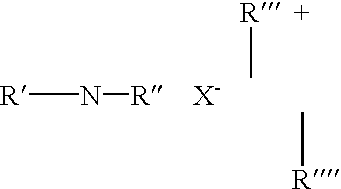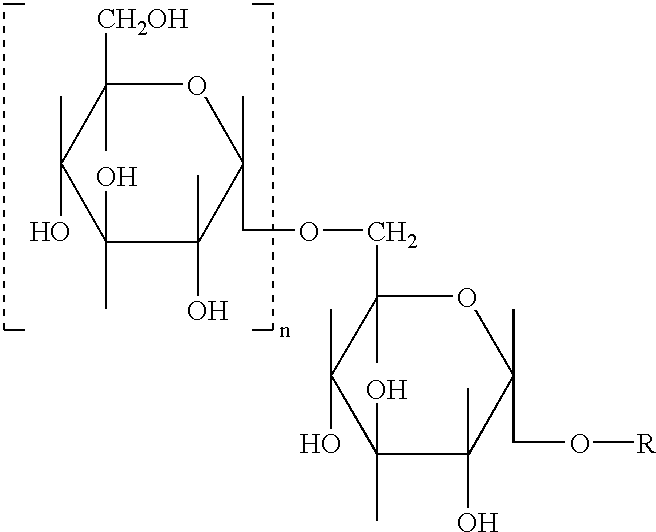Stable hydroalcoholic compositions
a technology of hydroalcoholic compositions and stable hydrocarbons, applied in the field of compositions, can solve the problems of reducing the surface tension of the hydroalcoholic emulsion dramatically, difficult to form stable viscose hydroalcoholic emulsions, and affecting the stability of the hydroalcoholic emulsion
- Summary
- Abstract
- Description
- Claims
- Application Information
AI Technical Summary
Benefits of technology
Problems solved by technology
Method used
Image
Examples
example 1
Alkyl Polyglucoside Thickener Systems
[0149] An alkyl polyglucoside emulsifier having an alkyl chain of 16 to 18 carbons was obtained as Montanov 68 from Seppic Inc. of Fairfield, N.J. This highly crystalline emulsifier was combined with other emulsifiers to form thickener systems in a hydroalcoholic solvent. The solvent was either 60:40 or 68:32 ethanol:water by weight. 200 proof ethanol and distilled water were used. The Montanov 68 / co-emulsifier ratio was varied keeping the total emulsifier concentration fixed at 5% by weight according to the following table:
3 Formulation (grams) Emulsifier A B C D Montanov 68 2 1.5 1 0.5 Co-emulsifier 0.5 1.0 1.5 2.0 60:40 ethanol:water 47.5 47.5 47.5 47.5
[0150] Each co-emulsifier / Montanov 68 composition was prepared using the following procedure:
[0151] 1. The emulsifiers were heated above their melting temperature to 75.degree. C.
[0152] 2. The hydroalcoholic solvent was heated to 75.degree. C. in a sealed jar.
[0153] 3. The hot hydroalcoholic sol...
example 2
Alkyl Polyglucoside / Brij 72 Optimization
[0158] A series of 15 formulations were prepared using a three component mixture design based on the results of Example 1. The following concentration ranges were investigated using a solvent ratio of 68:32 ethanol:water.
5 Component Percent by weight Montanov 68 0.26-3 Brij 72 1.0-5.2 Solvent 94-98
[0159] Each formulation was prepared and subsequently tested for stability and viscosity. The viscosities of the resulting formulations ranged from less than 50 cps to 93,600 cps. Stability results ranged from 0-83%. Examples of several optimized formulations appear below:
6 Stability Brij Viscosity (% volume Formula Montanov 68 72 Solvent (cps) separation) Percent by weight A 0.26 5.20 94.54 65,000 3 B 3.00 3.00 94 93,600 0 C 2.20 2.92 94.88 72,000 0 D 2.20 1.92 95.88 30,000 0 E 1.80 2.70 95.5 30,000 0 F 3.20 2.30 94.5 50,000 0
[0160] These results together with those of Example 1 indicate that the viscosity of the formula for this thickener system is...
example 3
Alkylpolyglucoside Ternary Thickener Systems
[0161] Based on the results obtained in Example 2, formulae E and F were chosen for use as base systems to which a third emulsifier was added to further increase the viscosity. The third emulsifier was added at concentrations of 0.3, 0.8, 1.3 and 1.8% by weight keeping the ratio of Montanov 68 and Brij 72 at the ratios found effective in formulations E and F of Example 2 according to the following table:
7 Formula Component A B C D E F G H Amount (grams) Montanov 68 0.92 0.92 0.92 0.92 1.11 1.11 1.11 1.11 Brij 72 1.37 1.37 1.37 1.37 1.55 1.55 1.55 1.55 Coemulsifier 0.15 0.40 0.65 0.90 0.15 0.40 0.65 0.90 Solvent 47.57 47.32 47.07 46.82 47.19 46.94 46.69 46.44
[0162] The solvent used was 68:32 ethanol:water. The formulations were prepared and subsequently tested for stability and viscosity. The third co-emulsifiers used were behenyl alcohol (Lanette 22, Henkel Corp.) and stearamide diethanolamine (Lipamide S, Lipo Chemical of Paterson, N.J.)....
PUM
| Property | Measurement | Unit |
|---|---|---|
| surface tension | aaaaa | aaaaa |
| surface tension | aaaaa | aaaaa |
| surface tension | aaaaa | aaaaa |
Abstract
Description
Claims
Application Information
 Login to View More
Login to View More - R&D
- Intellectual Property
- Life Sciences
- Materials
- Tech Scout
- Unparalleled Data Quality
- Higher Quality Content
- 60% Fewer Hallucinations
Browse by: Latest US Patents, China's latest patents, Technical Efficacy Thesaurus, Application Domain, Technology Topic, Popular Technical Reports.
© 2025 PatSnap. All rights reserved.Legal|Privacy policy|Modern Slavery Act Transparency Statement|Sitemap|About US| Contact US: help@patsnap.com



